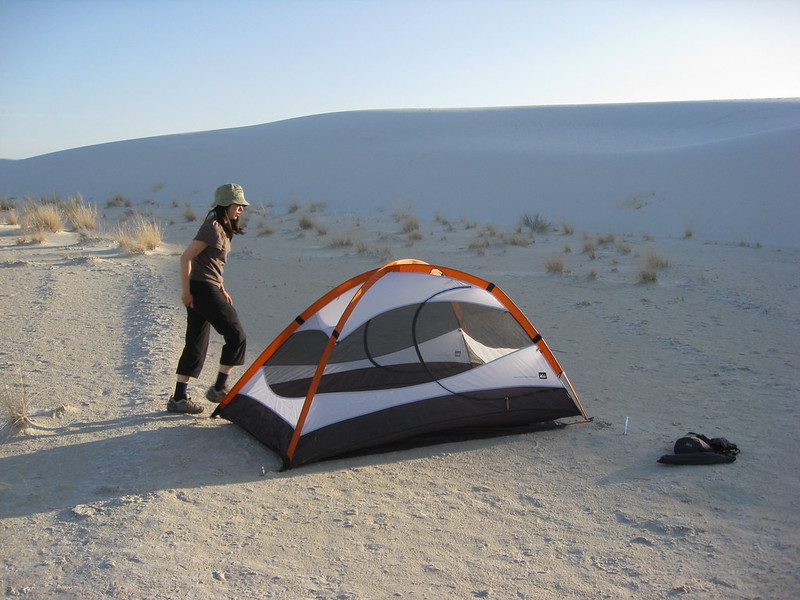White Sands National Park: An Oasis of Adventure
Nestled in the southern heart of New Mexico, White Sands National Park presents an otherworldly spectacle — a vast, gleaming expanse of gypsum sand dunes that stretch as far as the eye can see. Renowned for its ethereal landscapes that change shape with the winds, this national park is a dream destination for backcountry campers, hikers, and photographers alike. Here, the desert unfolds its charm in ways that are both subtle and stunning, offering unique experiences that you won’t find anywhere else on the planet. So, what better way to experience the park than backcountry camping.
Get more White Sands National Park News here!
Getting to White Sands National Park
White Sands National Park is located roughly 16 miles southwest of Alamogordo, New Mexico. The nearest airport is El Paso International Airport, approximately 85 miles south of the park. From there, you can rent a car and drive north on US Highway 54, turning onto US Highway 70 to reach the park. Prepare for a scenic journey as you traverse the arid landscapes of New Mexico, with the Sacramento Mountains on your left and the shimmering expanse of the White Sands on your right.
Best Time for Backcountry Camping at White Sands
Given its desert location, White Sands National Park can experience extreme temperatures. The best time to visit is during the cooler months of late fall, winter, and early spring. Summers can be intense, with daytime temperatures soaring above 100°F (38°C). However, the sand remains cool to the touch, even in peak summer, due to the high rate of evaporation of surface moisture.
The park can get crowded during the holiday season and spring break. Plan your visit on weekdays or during the shoulder season for a more peaceful experience.
Top Attractions and Activities
Dune Life Nature Trail
This 1-mile loop trail is perfect for families and beginner hikers. Interpretive signs along the path offer insights about the desert ecosystem, plant, and animal life.
Sledding on the Dunes
White Sands National Park is one of the few places where you can sled on sand. The visitor center sells sleds, or you can bring your own. The thrill of zooming down the soft gypsum dunes is an unmissable experience.
Full Moon Nights
The park hosts special programs on nights of the full moon from April through October. These include concerts, ranger talks, and the opportunity to explore the dunes under the silvery light of the moon.
Best Hikes and Trails
Alkali Flat Trail
- Distance: 5 miles round trip
- Elevation gain: Minimal
- Difficulty: Moderate
The Alkali Flat Trail is the longest established trail in the park, leading you through dune fields to the Alkali Flat, the dry lakebed of an ancient Pleistocene lake. Remember, there are no shade structures on this trail, so wear a hat and sunglasses, and bring plenty of water.
Backcountry Camping Trail
- Distance: 2 miles round trip
- Elevation gain: Minimal
- Difficulty: Easy
If you’re planning to camp in the backcountry, this is the trail for you. It leads to ten primitive camping sites amidst the dunes. A permit from the visitor center is required for backcountry camping.
Camping and Lodging Options
Backcountry camping is the primary option within the park, offering an unforgettable experience of sleeping under the stars amidst the dunes. There are ten sites available on a first-come-first-served basis, and permits can be obtained at the visitor center.
More traditional camping, RV parks, and hotels can be found in the nearby town of Alamogordo, about a 20-minute drive from the park.
Practical Travel Tips and Safety Considerations for Backcountry Camping at White Sands National Park
Hydration is crucial in this desert environment. The arid climate can dehydrate you quickly, even if you don’t feel thirsty. Bring ample water and drink regularly.
Temperatures can drop significantly after sunset, so pack warm clothing if you plan to stay overnight. Also, be prepared for the possibility of flash floods during summer thunderstorms.
Always stay on marked trails to avoid damaging the fragile desert ecosystem and getting lost. The shifting dunes can disorient even experienced hikers.
Top Photo Spots
The entire park is a photographer’s paradise, but some spots are particularly noteworthy. The Dune Life Nature Trail provides great opportunities to capture desert flora and fauna. The Interdune Boardwalk offers panoramic views of the dune fields. For the best landscape shots, head to Alkali Flat at sunset, when the setting sun casts a magical glow on the rippled dunes.
Whether you’re a seasoned backcountry camper or a first-time visitor, White Sands National Park offers an unparalleled desert experience. So grab your gear, hit the road, and prepare to be mesmerized by the luminous landscapes of this unique national treasure.
Follow us on Facebook for more up-to-date National Park content!


